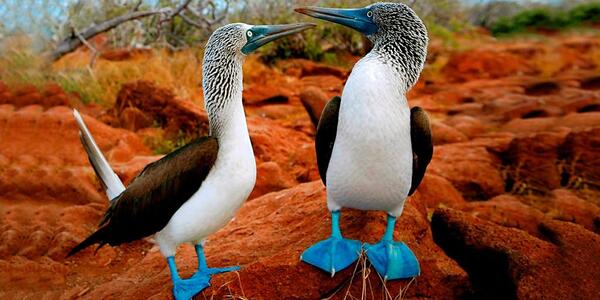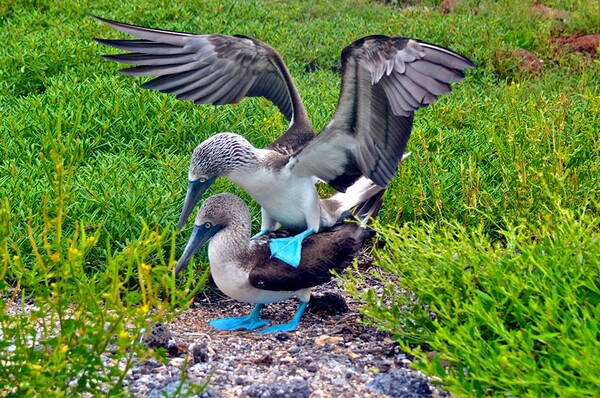Birds are a fascinating group of animals with vibrant colors, striking behaviors, and unique adaptations. Among them, the blue-footed booby stands out for its vivid blue feet—a feature that has captured the attention of bird enthusiasts and scientists alike. This article explores which birds have blue feet, delves into the characteristics and behaviors of the blue-footed booby, and examines the science behind their extraordinary blue pigmentation.
Blue feet are a rare and striking adaptation found in certain bird species, most famously in the blue-footed booby. These bright blue feet are not only visually stunning but also serve specific evolutionary and ecological purposes.
The vivid blue color comes from structural coloration, where the microscopic structure of the feet interacts with light to produce the vibrant hue. The intensity of the color depends on:
Diet: Foods rich in carotenoids, such as fish, enhance the vibrancy of their feet.
Health Indicators: The bluer the feet, the healthier the bird, making it an important feature during mating rituals.
Not all birds have blue feet. This feature is primarily associated with the blue-footed booby, although other birds may exhibit similar coloration in different body parts, such as feathers or beaks.

The blue-footed booby (Sula nebouxii) is the most well-known bird with blue feet. Let’s explore its unique traits.
Size: Medium-sized seabirds, with a wingspan of 5-6 feet.
Coloration: Brown and white plumage with striking blue feet.
Unique Feature: Their feet, ranging from pale blue to deep azure, are the highlight.
Found along the coasts of the eastern Pacific Ocean, from California to Peru.
Most famously associated with the Galápagos Islands, where they are a major tourist attraction.
Courtship Rituals: Their mating dance involves exaggerated foot-raising to showcase their bright blue feet.
Diet: They feed on fish, diving spectacularly into the ocean to catch prey.
Social Structure: They are highly social and often nest in colonies on rocky shores.
The vibrant blue color in the feet of the blue-footed booby is a fascinating example of nature’s artistry and evolution.
Unlike pigments, the blue coloration comes from structural coloration, where microscopic arrangements in the skin reflect light in a way that produces the blue hue.
Carotenoids, found in their diet of fish, enhance the brightness of their feet. A richer diet leads to more vibrant feet, which is a key indicator of a healthy and capable mate.
During courtship, brighter feet are more attractive to females, signaling superior genetics and health.
Studies show that males with duller feet are less likely to secure mates, emphasizing the role of visual cues in sexual selection.

While the blue-footed booby is the most famous example, other animals also exhibit unique foot colors:
Red-Footed Booby: Another booby species, known for its bright red feet.
Masked Booby: Features pale yellow feet, contrasting with its predominantly white body.
These species highlight the diversity of foot colors among marine birds and their ecological significance.
The blue-footed booby holds a special place in both science and culture.
The Galápagos Islands are a hotspot for birdwatching, with the blue-footed booby being a major attraction.
Conservation efforts aim to protect their habitats and ensure sustainable tourism.
The blue feet of these birds have inspired countless artworks, documentaries, and even mascots, symbolizing nature’s creativity and resilience.
Name Origin: “Booby” comes from the Spanish word bobo, meaning “fool,” referencing their clumsy movements on land.
Impressive Divers: They can plunge into water from heights of up to 80 feet to catch fish.
Family Dynamics: Both males and females share parenting duties, incubating eggs under their feet.
If you’re eager to witness these fascinating birds in the wild, here are some tips:
Visit the Galápagos Islands: The best location to see blue-footed boobies up close.
Coastal Tours in South America: Explore coasts of Ecuador, Peru, and nearby regions.
Join Ecotourism Expeditions: Participate in guided birdwatching tours to learn more about their behaviors and habitats.
The blue-footed booby is a marvel of the natural world, showcasing how evolution can produce both beauty and functionality. With their vibrant blue feet, these birds remind us of the intricate connections between appearance, health, and behavior in the animal kingdom. Whether through their graceful courtship dances or their dazzling dives, blue-footed boobies captivate all who encounter them.
Plan a trip to see these remarkable birds or delve deeper into the science of their unique adaptations—you’ll discover a world of wonder waiting in the vibrant blue feet of these iconic seabirds.
animal tags: Blue-Footed-Boobies
We created this article in conjunction with AI technology, then made sure it was fact-checked and edited by a Animals Top editor.